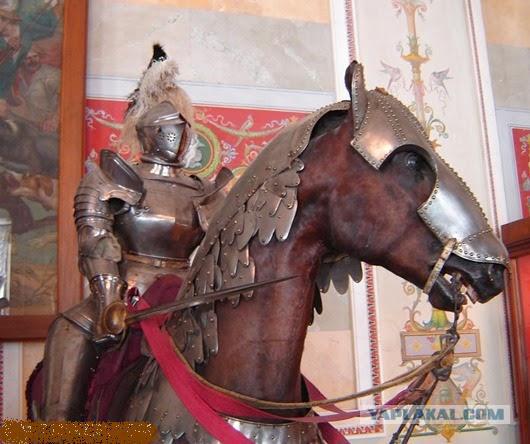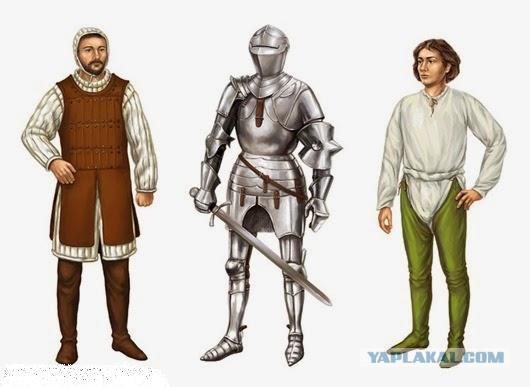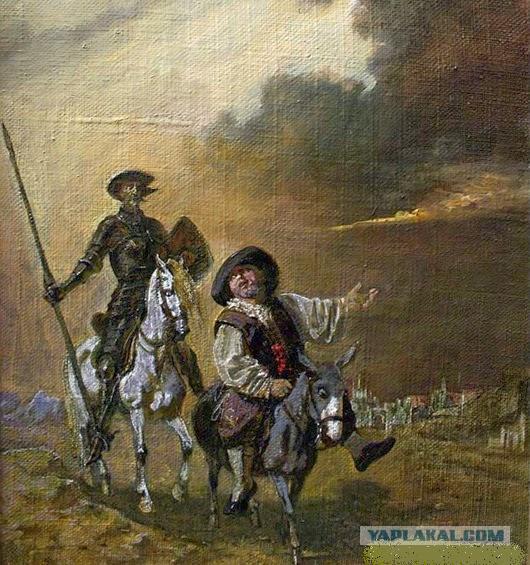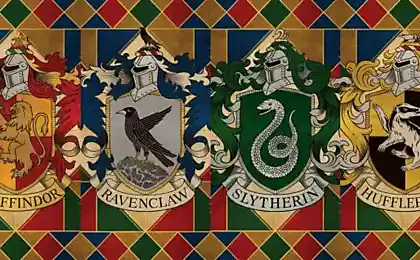1018
Chivalry without myths
"Yes, milled modern peasants - say women. - There is no more noble knights, ready to throw to the female feet the whole world, to fight for the heart of a beautiful lady with a dozen giants and selflessly love her all my life. But the modern woman met on his way this knight, believe me, she would have been horrified by this meeting. Created and supported by the female imagination romantic tales image of a strong, beautiful and virtuous knight, selflessly devoted to his beloved, has nothing to do with reality ...
18 photo source.

2
"Knight's armor weighed far too much, and the knight they could not climb on your own horse».
The myth takes its roots from the tournament armor that really over time more and more weighting, since intensified security requirements. But they are anywhere but the tournament and were not used. Battle armor were relatively light (around twenty kilograms). And allows you to comfortably wear them for quite some time (up to a couple days, of course, provided that elements such as hat, mittens / gloves and shin on the ability to shoot).
"The Prince of Wales in the Shell". Anthony van Dyck. 1637

3
Since armor had competent fastening system and weight distribution, the trained person almost felt uncomfortable in dealing with them and could not just climb and climb down from his horse without the aid of a page, but also easy to conduct manoeuvrable pedestrian battle.
Incidentally, testing before buying combat armor, knight often tried it pretty bold thing: for example, went wheel or dancing with a lady. And that - in combat then all can happen.
Also groundless myth that has fallen from the saddle knight could not stand myself. Got up as pretty if not fainted from damage. Exception - again, tournaments, where Knight was really sealed in armor from head to toe, but the tournament quickly get up after a fall was not necessary, since the fall of one of the knights of the horse, as a rule, it was the final point of the fight.
However, the rules differ from tournament to tournament, and sometimes swords Mahal to complete blackout.

4
"Knights fought to death and died hundreds» vs «Knights in armor were invulnerable».
Opposite in the same form and the content of delusions arising from two different branches of chivalry - "combat" and "glamorous».
On the merits, as mentioned above, a good armor was worth more than the farmer saw for life; perhaps, if he had not worked like hell someone would fork out. Mortality tournament battle decreases with time until it became tend to zero.
On the field battles more interesting. For a long time (up to approximately the fifteenth century) to kill a knight in armor quality was very difficult. Hence the popularity of fantasy swords are not, but all sorts of maces, Morgenstern, clubs, spears, halberds and similar: instead of unproductive cutting through armor stun carrier brute force.
"Jamming fish" was on the market, more precisely, for a ransom, not to its weight in gold, but in comparable orders. Therefore, in order to convey rasposledny Warrior podranennogo enemy overlord for money (as a commoner to receive a ransom is not shining knight) meant a chance for a good life.

5
One must note that the surrender is not a knight, and a common peasant knight was ashamed. Not that it was forbidden, then surrendered just getting ridiculed: friends - forget enemies - will scoff and noble ladies turn away. All of this could have been avoided ... devoting taker captured non-knight in the Knights.
However knights to surrender to the peasants still in no hurry, and usually tried to wait until someone more or less noble in appearance, and only then shout wish to surrender (if the last face-control turned out to be non-knight, his and be devoted to Knights). So take a knight in captivity for a commoner was a big success but lucky, fortunate, still were.
Through this, the vast majority of combat losses of chivalry held by Category wounded and captured, and the leading cause of death turns out to be the enemy's blade, and consequential gangrene (for the concept to antiseptics in medicine had to stretch just a couple of hundred years, the same Lionheart, some ten days agony - and all).
On the other hand, some of the war (the especially famous for religious implicated, such as the Albigensian, and based on mutual hatred overripe, such as constantly receives from the British and French) were already completely on another planet not only on considerations of chivalry, but from a completely monetary benefits .
In such cases, suddenly discovers that if captured and stunned finish, the knights should be very "meminisse mori". Well, with the gradual spread of first powerful bows and crossbows successfully pierces armor (Battle of Poitiers is still considered among historians exemplary example), and then firearms, survival knights became really close to that, which, in turn, has led to sunset the entire thread.
It is worth noting that emerged in the late Middle Ages Swiss battles took no prisoners in principle (it was expressly prohibited by statute), which led to the wild battherta noble dons when militia confederation democratic state of dirty Muzhichi forbidding carved flower of the nation. But it's a different story and a different time.

6
"Sword - that weapon worthy knight».
Raspiarenny cliché, whose roots are lost in the centuries, namely, in the history of the Celts, who worshiped the weapon. Their Roman Greek neighbors considered the main feature of the spear. Sword and its variants - is not even a fetish of the Middle Ages, and to a greater extent of the Ancient World.
The ancestors of the EU Democrats a couple of thousand years ago, ran through the woods and fields with these same "kovyryalami" ready and very fond of each other's heads cut off. For armor in those hard times could not even afford a Saxon or Frankish leader, but from the iron-clad legionnaires easier to run anywhere, as long as intact.
Hands and feet all enemies almost naked - I do not want to chop off. And that's just in cutting off the glorious "kovyryalniku" with a heavy blade no equal. Remained the same in the Early Middle Ages. Trash Scandinavian sagas are full of references legless and armless.
You have to understand that along with many others, metallurgy - science, to get a real development until modern times. Long and flat sheet metal in ancient times could be either soft or brittle, or not quite one and the other, but astronomically expensive.
So beloved by professionals of arms "Damascus steel", is obtained by adding once prokovannogo sheet in half and re-forging, - the process was repeated several times, that actually carried enormous effort in production and the corresponding value of the finished product. About damask and say nothing, alloying and doping in closed crucibles without a precise process in terms of efficiency comparable to shamanic dancing (that does not negate the excellent quality of successful products).

7
Hence the legends of ancient swords, which fought more great-great-great-grandfather of the owner, if not some of Cthulhu - a sword was not the most efficient and the most expensive and pontovo weapons. They not only were cut as shaken at any feasts.
Sword fine cuts skinned black, which is spearmen units and other privates. They can be wonderful fence, and in general, it is easiest with a sword to show superiority in speed and skill. Good sword even quite effective against armor "economy class" (so-called "ayzenpantser", which the German nick deservedly renamed "shayzenpantser»).
Unfortunately, against an opponent in the vast majority of the Milanese armor swords work worse scrap as weigh less. Logical way - heavier sword, so we get the first Claymore, whom brave mountaineers were cut more than one hundred years, and then race Zweihänder (two-handed, he's Espadon), with which arm dirty bearded mercenaries - they are equally well cut through the wall as copies of Swiss battles and the full armor of noble knights.
A gloomy medieval hacker guessed instead of increasing the impact force to reduce the contact area - so was born Flamberge, a sword with a wavy blade. It cost a little more than all the uniforms, but well past armor, almost they do not get stuck, and when removing the suit surgical nightmare because of the cutting edges of the wound thin slices Aki teeth of a saw, which guaranteed death either immediately or later from blood loss from gangrene.
Soon Flamberge was cursed by the Church as inhumane, even by the standards of those times weapons and hit the prisoner with a gizmo led to immediate execution.

8
Alternatively, clubs, maces, clubs, flails, morningstar, battle hammers and flails quite a bit inconvenient for slaughter (not so convenient to block, parry and do other tricks fencing), but qualitatively different work against armor instead little meaningful logging iron, causing shock damage through clothing directly into the body. "The corpse looks like a living," they say.
A Klevtsov hammered and other battle-axes and ax all evolved from a tool for cutting wood, that is originally designed for maximum impact on the concentration of a minimal surface. Very saddened looters as armor with holes left huckster at a discount. In addition, all of the above technology represents a piece of metal, no matter what the quality, just stuffed with a wooden handle.
And if the nick on the sword for the repair required a blacksmith and forge (at least camp), the preservation of the clubs in the campaign could not worry about making it mandatory second arms each Crusader.
In general, the historical significance of the sword is the subject of constant debate between the various historians, re-enactors and joined them fantasy readers. Characteristically, somewhere very well observed and studied 17+ century, after the disappearance of armor on the battlefield (as described in the preceding paragraph reasons), swords for officers quickly replaced at extremely lightweight sword (cavalry, however, remained with swords because galloping better cut than pierce less likely that the weapon stuck in the corpse).
The result is easy to see that armor - mace without them - sword, without money - a spear (as opposed to all of the above do not go out of fashion at all), but a sword - a hybrid of the first and second without the slightest attention to the third, if not considered Polish or French Koncar estoque - half-meter cavalry sword.
Well, in the end it strange instrument has questionable utility in literature and culture spread far greater than ever.

9
"The Knights were terrible messy».
Knights were not cleaner and dirtier than other people in Europe at that time. Another thing is that by the standards of enlightened twenty-first century "terrible slut" then were generally all.
Shit for themselves, however, was not accepted. Medieval clothing and armor maximum facilitates spravleniya small and large needs. At that time there was no pants in their classical sense, but were so-called highway, which represent the woolen stockings that tie to the lower belt, and in the fifteenth century and became seaming zaimeli braget - valve front (so as not to complicate the procedure).
Function of protecting the loins of ambient air performed medieval Panza, called "ber", which have long-grandson, now known as the "little family". They often have long legs (if you can call it that), tucked into the highway. So as not ash pit. Even being dressed in armor, making it easy - a matter of minutes, as the armor was always open at the bottom.
But we digress. The bottom line is that the Knights though Dirt, but I understand that things like defecation and urination in Bray attracted to very unpleasant consequences for the skin and overall health. A view of the stench of knights took place on several other reasons - wearing a tight sweater over-poddospeshnik and actively Weave long three-chetyrёhkilogrammovym scrap for half an hour under the hot sun Palestine. Do you hear, what smells?

10
"Knights of not washing clothes for a long time».
This myth is true, but only partly. The fact is that in the Middle Ages not only erase outerwear. Lower, which is a kameez (shirt) and Bray (pants little family), erased as often as possible. Moreover, in the medium was popular chivalric Institute vows - a kind of sacred oath that knight, once given, then had to hold the stipulated period and nothing else.
Of course, the Knights did not give the fundamental vows with a few exceptions, most often swore a certain time or until a certain event wearing some pathetic nickname, do not shave, do not cut your nails, do not wash your body, not plump wine each, in short, in every possible way to embarrass yourself, but not globally.

11
"The knights had iron discipline».
We all remember from history textbook that chivalry was not clear capital statutes and there was no single organization that they are being watched. But it was the notion of equality and suzerainty. Equality originally meant that all the knights are equal, and the rules they only worthy of being equal.
Suzerainty consists of a hierarchy of subordination, which we know from school, "vassal of my vassal is not my vassal." The first and second brings to the ordinary life of chivalry such cheerful debate on what, who, and how to do that sometimes marching camp was turned into a noble farce.
Knight personified the ideal of the medieval understanding of masculinity, that is gone, "Rabbit Rabbit", played muscles before babtsy, flared nostrils and again played the muscles in front of the men. This knight could not in any case allow itself to overshadow those in rank was below its least half a millimeter, he always wanted to be the most-often inflamed causing the threat of his illusions.
For this reason, charges feudal lord, having commanded a large army to determine who will lead the whole horde proud Muzhichi iron, turned into competitions in which the argument sometimes becomes a sword, and there were real victims, why suffer the political success of the company (not all good Generals - good fencers, and vice versa).
One of the reasons, by the way, is why many knights chose to pray to the Virgin Mary - she is not a man, not in front of Mrs. defective knelt, whereas before God himself some "zheleznolobye" feel uncomfortable. We should also add that to solve discipline problems were created knightly orders.

12
"Knights traveled and fought alone».
Do not talk about squires (one or more), without which a knight - a modern CEO without a secretary. Normal Knight comes complete with a so-called "knightly spear." Where were he squires, pages and from two or three to several tens of cavalry and infantry, archers and soldiers, horse-headed sergeant. Number based on financial opportunities knight, as clothed, armed and paid them the chief coin out of his pocket.
The image of the knight errant single was a very favorite authors romances (including the Middle Ages). The reasons probably the same as the "spear" - commoners for the people and not considered "alone" actually meant that the noble knight is not accompanied by one of the nobles, and even armor-bearer, and he was not eskvayer and serf. Fortunately, that situation when traveling "alone" knight suddenly something tells his servant is not rare.

13
And the audience in those days had the opportunity to more clearly see that the hero of romance is different from the usual knight just like Indiana Jones - from the average archaeologist.
Today, the image of chivalry for the layman is almost the only source of information about the subject, but the cultural and historical nuances are lost, because of what appeared this myth.
Of course, the knights alone without "spear" and generally without anything but armor and horse - quite a real historical figure in certain periods in certain areas. But they are usually preferred if wander, the gang gathered, sometimes very rather big, because the main source of livelihood to engage in the journey alone - as something absolutely "not in cash."

14
"The dominance of knights and strong army of knights»
Source:
18 photo source.

2
"Knight's armor weighed far too much, and the knight they could not climb on your own horse».
The myth takes its roots from the tournament armor that really over time more and more weighting, since intensified security requirements. But they are anywhere but the tournament and were not used. Battle armor were relatively light (around twenty kilograms). And allows you to comfortably wear them for quite some time (up to a couple days, of course, provided that elements such as hat, mittens / gloves and shin on the ability to shoot).
"The Prince of Wales in the Shell". Anthony van Dyck. 1637

3
Since armor had competent fastening system and weight distribution, the trained person almost felt uncomfortable in dealing with them and could not just climb and climb down from his horse without the aid of a page, but also easy to conduct manoeuvrable pedestrian battle.
Incidentally, testing before buying combat armor, knight often tried it pretty bold thing: for example, went wheel or dancing with a lady. And that - in combat then all can happen.
Also groundless myth that has fallen from the saddle knight could not stand myself. Got up as pretty if not fainted from damage. Exception - again, tournaments, where Knight was really sealed in armor from head to toe, but the tournament quickly get up after a fall was not necessary, since the fall of one of the knights of the horse, as a rule, it was the final point of the fight.
However, the rules differ from tournament to tournament, and sometimes swords Mahal to complete blackout.

4
"Knights fought to death and died hundreds» vs «Knights in armor were invulnerable».
Opposite in the same form and the content of delusions arising from two different branches of chivalry - "combat" and "glamorous».
On the merits, as mentioned above, a good armor was worth more than the farmer saw for life; perhaps, if he had not worked like hell someone would fork out. Mortality tournament battle decreases with time until it became tend to zero.
On the field battles more interesting. For a long time (up to approximately the fifteenth century) to kill a knight in armor quality was very difficult. Hence the popularity of fantasy swords are not, but all sorts of maces, Morgenstern, clubs, spears, halberds and similar: instead of unproductive cutting through armor stun carrier brute force.
"Jamming fish" was on the market, more precisely, for a ransom, not to its weight in gold, but in comparable orders. Therefore, in order to convey rasposledny Warrior podranennogo enemy overlord for money (as a commoner to receive a ransom is not shining knight) meant a chance for a good life.

5
One must note that the surrender is not a knight, and a common peasant knight was ashamed. Not that it was forbidden, then surrendered just getting ridiculed: friends - forget enemies - will scoff and noble ladies turn away. All of this could have been avoided ... devoting taker captured non-knight in the Knights.
However knights to surrender to the peasants still in no hurry, and usually tried to wait until someone more or less noble in appearance, and only then shout wish to surrender (if the last face-control turned out to be non-knight, his and be devoted to Knights). So take a knight in captivity for a commoner was a big success but lucky, fortunate, still were.
Through this, the vast majority of combat losses of chivalry held by Category wounded and captured, and the leading cause of death turns out to be the enemy's blade, and consequential gangrene (for the concept to antiseptics in medicine had to stretch just a couple of hundred years, the same Lionheart, some ten days agony - and all).
On the other hand, some of the war (the especially famous for religious implicated, such as the Albigensian, and based on mutual hatred overripe, such as constantly receives from the British and French) were already completely on another planet not only on considerations of chivalry, but from a completely monetary benefits .
In such cases, suddenly discovers that if captured and stunned finish, the knights should be very "meminisse mori". Well, with the gradual spread of first powerful bows and crossbows successfully pierces armor (Battle of Poitiers is still considered among historians exemplary example), and then firearms, survival knights became really close to that, which, in turn, has led to sunset the entire thread.
It is worth noting that emerged in the late Middle Ages Swiss battles took no prisoners in principle (it was expressly prohibited by statute), which led to the wild battherta noble dons when militia confederation democratic state of dirty Muzhichi forbidding carved flower of the nation. But it's a different story and a different time.

6
"Sword - that weapon worthy knight».
Raspiarenny cliché, whose roots are lost in the centuries, namely, in the history of the Celts, who worshiped the weapon. Their Roman Greek neighbors considered the main feature of the spear. Sword and its variants - is not even a fetish of the Middle Ages, and to a greater extent of the Ancient World.
The ancestors of the EU Democrats a couple of thousand years ago, ran through the woods and fields with these same "kovyryalami" ready and very fond of each other's heads cut off. For armor in those hard times could not even afford a Saxon or Frankish leader, but from the iron-clad legionnaires easier to run anywhere, as long as intact.
Hands and feet all enemies almost naked - I do not want to chop off. And that's just in cutting off the glorious "kovyryalniku" with a heavy blade no equal. Remained the same in the Early Middle Ages. Trash Scandinavian sagas are full of references legless and armless.
You have to understand that along with many others, metallurgy - science, to get a real development until modern times. Long and flat sheet metal in ancient times could be either soft or brittle, or not quite one and the other, but astronomically expensive.
So beloved by professionals of arms "Damascus steel", is obtained by adding once prokovannogo sheet in half and re-forging, - the process was repeated several times, that actually carried enormous effort in production and the corresponding value of the finished product. About damask and say nothing, alloying and doping in closed crucibles without a precise process in terms of efficiency comparable to shamanic dancing (that does not negate the excellent quality of successful products).

7
Hence the legends of ancient swords, which fought more great-great-great-grandfather of the owner, if not some of Cthulhu - a sword was not the most efficient and the most expensive and pontovo weapons. They not only were cut as shaken at any feasts.
Sword fine cuts skinned black, which is spearmen units and other privates. They can be wonderful fence, and in general, it is easiest with a sword to show superiority in speed and skill. Good sword even quite effective against armor "economy class" (so-called "ayzenpantser", which the German nick deservedly renamed "shayzenpantser»).
Unfortunately, against an opponent in the vast majority of the Milanese armor swords work worse scrap as weigh less. Logical way - heavier sword, so we get the first Claymore, whom brave mountaineers were cut more than one hundred years, and then race Zweihänder (two-handed, he's Espadon), with which arm dirty bearded mercenaries - they are equally well cut through the wall as copies of Swiss battles and the full armor of noble knights.
A gloomy medieval hacker guessed instead of increasing the impact force to reduce the contact area - so was born Flamberge, a sword with a wavy blade. It cost a little more than all the uniforms, but well past armor, almost they do not get stuck, and when removing the suit surgical nightmare because of the cutting edges of the wound thin slices Aki teeth of a saw, which guaranteed death either immediately or later from blood loss from gangrene.
Soon Flamberge was cursed by the Church as inhumane, even by the standards of those times weapons and hit the prisoner with a gizmo led to immediate execution.

8
Alternatively, clubs, maces, clubs, flails, morningstar, battle hammers and flails quite a bit inconvenient for slaughter (not so convenient to block, parry and do other tricks fencing), but qualitatively different work against armor instead little meaningful logging iron, causing shock damage through clothing directly into the body. "The corpse looks like a living," they say.
A Klevtsov hammered and other battle-axes and ax all evolved from a tool for cutting wood, that is originally designed for maximum impact on the concentration of a minimal surface. Very saddened looters as armor with holes left huckster at a discount. In addition, all of the above technology represents a piece of metal, no matter what the quality, just stuffed with a wooden handle.
And if the nick on the sword for the repair required a blacksmith and forge (at least camp), the preservation of the clubs in the campaign could not worry about making it mandatory second arms each Crusader.
In general, the historical significance of the sword is the subject of constant debate between the various historians, re-enactors and joined them fantasy readers. Characteristically, somewhere very well observed and studied 17+ century, after the disappearance of armor on the battlefield (as described in the preceding paragraph reasons), swords for officers quickly replaced at extremely lightweight sword (cavalry, however, remained with swords because galloping better cut than pierce less likely that the weapon stuck in the corpse).
The result is easy to see that armor - mace without them - sword, without money - a spear (as opposed to all of the above do not go out of fashion at all), but a sword - a hybrid of the first and second without the slightest attention to the third, if not considered Polish or French Koncar estoque - half-meter cavalry sword.
Well, in the end it strange instrument has questionable utility in literature and culture spread far greater than ever.

9
"The Knights were terrible messy».
Knights were not cleaner and dirtier than other people in Europe at that time. Another thing is that by the standards of enlightened twenty-first century "terrible slut" then were generally all.
Shit for themselves, however, was not accepted. Medieval clothing and armor maximum facilitates spravleniya small and large needs. At that time there was no pants in their classical sense, but were so-called highway, which represent the woolen stockings that tie to the lower belt, and in the fifteenth century and became seaming zaimeli braget - valve front (so as not to complicate the procedure).
Function of protecting the loins of ambient air performed medieval Panza, called "ber", which have long-grandson, now known as the "little family". They often have long legs (if you can call it that), tucked into the highway. So as not ash pit. Even being dressed in armor, making it easy - a matter of minutes, as the armor was always open at the bottom.
But we digress. The bottom line is that the Knights though Dirt, but I understand that things like defecation and urination in Bray attracted to very unpleasant consequences for the skin and overall health. A view of the stench of knights took place on several other reasons - wearing a tight sweater over-poddospeshnik and actively Weave long three-chetyrёhkilogrammovym scrap for half an hour under the hot sun Palestine. Do you hear, what smells?

10
"Knights of not washing clothes for a long time».
This myth is true, but only partly. The fact is that in the Middle Ages not only erase outerwear. Lower, which is a kameez (shirt) and Bray (pants little family), erased as often as possible. Moreover, in the medium was popular chivalric Institute vows - a kind of sacred oath that knight, once given, then had to hold the stipulated period and nothing else.
Of course, the Knights did not give the fundamental vows with a few exceptions, most often swore a certain time or until a certain event wearing some pathetic nickname, do not shave, do not cut your nails, do not wash your body, not plump wine each, in short, in every possible way to embarrass yourself, but not globally.

11
"The knights had iron discipline».
We all remember from history textbook that chivalry was not clear capital statutes and there was no single organization that they are being watched. But it was the notion of equality and suzerainty. Equality originally meant that all the knights are equal, and the rules they only worthy of being equal.
Suzerainty consists of a hierarchy of subordination, which we know from school, "vassal of my vassal is not my vassal." The first and second brings to the ordinary life of chivalry such cheerful debate on what, who, and how to do that sometimes marching camp was turned into a noble farce.
Knight personified the ideal of the medieval understanding of masculinity, that is gone, "Rabbit Rabbit", played muscles before babtsy, flared nostrils and again played the muscles in front of the men. This knight could not in any case allow itself to overshadow those in rank was below its least half a millimeter, he always wanted to be the most-often inflamed causing the threat of his illusions.
For this reason, charges feudal lord, having commanded a large army to determine who will lead the whole horde proud Muzhichi iron, turned into competitions in which the argument sometimes becomes a sword, and there were real victims, why suffer the political success of the company (not all good Generals - good fencers, and vice versa).
One of the reasons, by the way, is why many knights chose to pray to the Virgin Mary - she is not a man, not in front of Mrs. defective knelt, whereas before God himself some "zheleznolobye" feel uncomfortable. We should also add that to solve discipline problems were created knightly orders.

12
"Knights traveled and fought alone».
Do not talk about squires (one or more), without which a knight - a modern CEO without a secretary. Normal Knight comes complete with a so-called "knightly spear." Where were he squires, pages and from two or three to several tens of cavalry and infantry, archers and soldiers, horse-headed sergeant. Number based on financial opportunities knight, as clothed, armed and paid them the chief coin out of his pocket.
The image of the knight errant single was a very favorite authors romances (including the Middle Ages). The reasons probably the same as the "spear" - commoners for the people and not considered "alone" actually meant that the noble knight is not accompanied by one of the nobles, and even armor-bearer, and he was not eskvayer and serf. Fortunately, that situation when traveling "alone" knight suddenly something tells his servant is not rare.

13
And the audience in those days had the opportunity to more clearly see that the hero of romance is different from the usual knight just like Indiana Jones - from the average archaeologist.
Today, the image of chivalry for the layman is almost the only source of information about the subject, but the cultural and historical nuances are lost, because of what appeared this myth.
Of course, the knights alone without "spear" and generally without anything but armor and horse - quite a real historical figure in certain periods in certain areas. But they are usually preferred if wander, the gang gathered, sometimes very rather big, because the main source of livelihood to engage in the journey alone - as something absolutely "not in cash."

14
"The dominance of knights and strong army of knights»
Source:






















